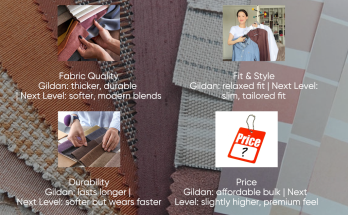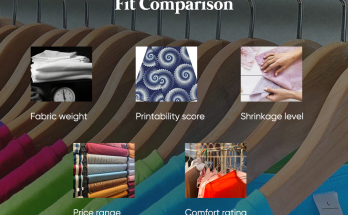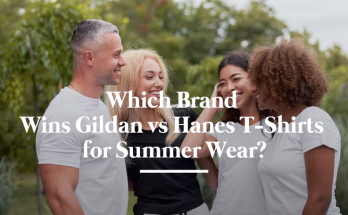Executive Summary
Alstyle vs comfort colors: why do you need this comparison?
Choosing between Alstyle and Comfort Colours can be challenging for clothing brands, screen printers, and retailers seeking the ideal balance of quality, fit, and price. This blog compares Alstyle 1301 vs Comfort Colours 1717 in terms of fabric weight, softness, dye process, shrinkage, printability, and cost efficiency. Backed by authoritative data from official spec sheets, this post helps you determine which blank T-shirt performs best for your business goals, whether that’s achieving a vintage pigment-dyed look or producing crisp, structured prints at scale.

Alstyle Vs. Comfort Colors: Why You Need This Comparison.
Style is a way to say who you are without having to speak.”
Rachel Zoe, Celebrity Stylist & Designer
In the world of blank apparel, few debates engage garment decorators, clothing brands, and bulk buyers. Most of the time, this debate includes a comparison between Alstyle and Comfort Colours. Whether you’re planning a new streetwear line, a band merchandise run, or ordering bulk tees for a promotional event, the choice between Alstyle blank T-shirts and Comfort Colours can directly affect your product’s look, printability, durability, and margins.
Consider this: Comfort Colors’ 1717 style is marketed as a 6.1 oz ring-spun, garment-dyed heavyweight tee with minimal shrinkage and a “lived-in” feel. Meanwhile, one of Alstyle’s flagship blanks, the Alstyle 1301, is a 6 oz preshrunk heavyweight 100% cotton tee with a tear-away label and classic cut.
So which is better? Which blank tee is more suitable for screen printing, holds up in bulk, and provides the best fit? In this blog, we’ll help you decide by comparing Comfort Colors vs Alstyle across key dimensions.
Key Takeaways
- Fit & drape: Comfort Colors leans toward a relaxed, vintage-washed silhouette; Alstyle (especially 1301) offers a more structured, classic cut.
- Fabric & feel: Both are made from heavy cotton, but Comfort Colours’ garment dyeing process gives a softer, worn-in hand feel.
- Shrinkage & colourfastness: Comfort Colours’ garment-dye and preshrinking process yield better consistency; Alstyle’s preshrunk fabrics are solid but vary by dye lot.
- Printability: Alstyle offers sharper registration and colour pop; Comfort Colours may require ink adjustments for pigment-dyed surfaces.
- Cost efficiency: Alstyle blanks are generally more affordable in bulk orders; Comfort Colors commands a premium for its unique finish.
- Best for: Vintage streetwear brands → Comfort Colors; Screen printers seeking precision and value → Alstyle.
Why This Debate Matters
According to Yahoo Finance (2025), the global blank apparel market, including T-shirts used for customization and screen printing, is valued at over $8.9 billion, with the U.S. representing nearly 45% of total demand. The growing popularity of custom streetwear, sustainable cotton apparel, and vintage-dyed aesthetics drives this surge.
When you’re running a bulk apparel order in the USA, the difference in cost, consistency, and quality between Comfort Colors and Alstyle in bulk orders can mean the difference between a wildly successful drop and high return rates.
- For design-forward apparel brands, the “vintage wash” achieved by Comfort Colours through pigment dying is a strong selling point.
- However, for screen printers, screen printing concerns, especially when using plastisol, discharge, or white inks, can shift the balance.
- Additionally, Alstyle is now part of the broader Gildan/American Apparel family, meaning your supply chain, lead times, and quality control must factor in the parent company’s policies.
Let’s delve deeper into how these brands compare across various facets.
Deep Dive: Alstyle Vs. Comfort Colors
Brand Background & Ownership
- Alstyle lineage: Alstyle 1301 is sold under the Alstyle (or increasingly American apparel) label, with Gildan as a parent or affiliated manufacturer.
- Comfort Colours brand identity: Comfort Colours places a strong emphasis on garment-dyeing, vintage appeal, relaxed fits, and a palette of washed / pigment-dye colours.
- Because both brands fall under the Gildan umbrella (or its allied operations), they share supply chain efficiencies; however, their product philosophies diverge.
Fabric & Construction Specs
Fit, Drape & Wearability
- Fit differences: Comfort Colors is known for a more relaxed drape and vintage aesthetic. Many decorators and wearers compare Alstyle’s necks and bodies to be stiffer or more boxy.
- Shrinkage & shape retention: Comfort Colours’ garment-dye and washing process helps minimize post-laundering changes. Meanwhile, Alstyle’s preshrunk claims are accurate, but dye-lot variation and heavy prints can still cause the fabric to stretch.
- Softness: From the first wash onward, Comfort Colours tends to soften more quickly, imparting a “vintage” touch. Alstyle stiffens less over time, but may not feel as soft initially.
Printability & Screen Printing Performance
- Surface & ink adherence: Because Comfort Colors blanks are pigment-dyed (especially many of their colors), the dye is less deeply absorbed. It can make white or opaque inks slightly more challenging to print cleanly (you may need underbase, adjusted curing, or ink layering).
- With Alstyle blanks, the base cotton is less “pre-distressed” so inks can sit on a more consistent canvas, aiding sharper lines, finer detail, and better registration.
- Curing & wash durability: Both brands perform well if printing is done correctly. However, soft finishes or pigment dye textures (in Comfort Colours) may require gentler curing to prevent scorching or shade shifting.
- Edge crispness: On very detailed designs or halftones, Alstyle may edge out by a small margin due to lesser “texture noise” on the fabric.
Durability, Fade & Colourfastness
- Colour retention: Comfort Colours’ pigment-dye process inherently produces slight shade variations and a “lived-in” fade over time, which is often a desired aesthetic. But extreme UV, bleach, or harsh laundering may exaggerate fading.
- Fabric wear & tear: Because Alstyle’s fabric is denser and less pre-treated, it may resist abrasion or pilling slightly better in high-stress zones (such as elbows and seams).
- Shrinkage over time: Comfort Colors’ preshrink and garment-dye process helps stabilize the garment. Alstyle’s preshrunk construction is good, but end-user laundering practices (using hot water and a dryer) can cause more shape change.
Cost, Bulk Orders & Availability
- Cost per unit: Typically, Alstyle blanks are competitively priced, especially in bulk quantities. Comfort Colors come at a premium, often due to the cost of dyeing, finishing, and a complex colour palette.
- Bulk order logistics (USA): Ordering Comfort Colours in bulk can result in higher freight costs, fewer discount tiers (especially for speciality colours), and extended lead times. Alstyle, being more “simplified” in dye options, may offer better scaling.
- Colour variety and inventory: Comfort Colours offers a broad palette of pigment-dye shades, which is ideal for design flexibility. But less common colours may be harder to source. Alstyle’s color offerings may be more basic, but they are more straightforward to stock consistently.
- Transition: Note that Alstyle 1301 is transitioning under the American Apparel label in many supply chains. You may receive mixed labelling during the transition period.

Real-World Scenarios
Creative Use Cases: Mixing Comfort Colors and Alstyle
Why Combine Comfort Colors and Alstyle?
Combining Alstyle and Comfort Colors can unlock the best of both worlds for brands and creators who love pushing the boundaries of design. Comfort Colours is renowned for its pigment-dye and garment-washed finishes, which impart T-shirts with a soft, vintage patina and a naturally lived-in appearance. These shirts are ideal for collections that lean into earthy tones, muted hues, and vintage-inspired colour palettes, perfect for streetwear, lifestyle, or artistic branding.
Alstyle for Sharp and Vibrant Designs
On the other hand, Alstyle shines when you need sharper, brighter, and more defined prints. Its tight-knit, ring-spun cotton fabric makes it excellent for screen printing, direct-to-garment (DTG) printing, and high-contrast graphic designs. The clean base of Alstyle tees allows colors to pop, ensuring that every line and gradient comes through vividly.
Balancing Texture, Aesthetics, and Efficiency
When used together, these brands provide a balanced approach. Comfort Colours brings warmth, texture, and a nostalgic vibe, while Alstyle delivers crispness, precision, and affordability. Many apparel brands mix both for seasonal collections: Comfort Colors for premium pigment-dye drops, and Alstyle for classic bright designs or promotional runs. This hybrid strategy enables creators to achieve both aesthetic diversity and production efficiency without compromising quality or brand integrity.
Alstyle vs Comfort Colors: Based on Your Priorities
If You Value a Vintage, Washed Aesthetic
Choose Comfort Colors. This brand is made for those who love that sun-faded, garment-dyed look that feels naturally worn in from the very first wear. The brand’s signature pigment-dye process delivers a beautifully uneven tone and character in each shirt, giving it a vintage charm that appeals to streetwear, boutique fashion, and lifestyle brands. If your focus is on authentic texture, soft hues, and visual warmth, Comfort Colors is the clear winner.
If Softness and Comfort Are Your Top Priority
Again, Comfort Colors leads in this category thanks to its ring-spun cotton and pre-washed finish. The shirts feel incredibly soft and cozy right out of the box, requiring no break-in period. This makes them ideal for premium retail collections, custom brand drops, or even teamwear where comfort matters as much as style.
If You Need Bright Colors and Print Sharpness
Go with Alstyle, especially the Alstyle 1301. Known for its smooth, tight-knit surface, this shirt handles screen printing and DTG (Direct-to-Garment) applications with exceptional clarity. Designs with high contrast, fine lines, or vibrant artwork come out crisp and clean. If your brand’s identity relies on bold visuals, sharp graphics, or detailed prints, Alstyle delivers superior precision and consistency.
If You’re Focused on Cost Efficiency and Bulk Orders
Alstyle excels in cost-sensitive production. It offers high-quality wholesale blanks at a competitive price point, without compromising durability or color accuracy. For businesses that produce large batches, event merchandise, or promotional wear, Alstyle blanks make financial sense while maintaining a professional and reliable look.
If Consistency and Control Matter Most
Both brands perform well here, but Alstyle offers slightly more production consistency. Its uniform fabric weight and weave ensure predictable print outcomes and minimal variability between batches. Comfort Colors can vary slightly due to the pigment-dyeing process, which gives each piece its unique character with a plus for artistry, but a consideration for bulk printing.
If You Want to Minimize Shrinkage
Both Comfort Colours and Alstyle are preshrunk, but the degree of shrinkage may vary depending on the care practices. Comfort Colors holds up well, though pigment dyeing can introduce minor variations. Alstyle maintains shape reliably, provided proper laundering methods are followed (cold wash, low tumble dry).
Action (Next Steps & Tips)
- Order samples: Buy both a few Alstyle 1301 blanks and Comfort Colours 1717 blanks in your core sizes and wash them side by side (cold wash, hang dry; hot wash, tumble dry).
- Test your prints: Screen print a demanding, high-detail design on both to see edge crispness, registration behavior, and ink bleed.
- Evaluate colour behaviour: Track colour fading, changes in softness, and shrinkage across multiple cycles.
- Balance your catalogue: For brand drops, use Comfort Colours for pigment-dyed “seasonal / washed” lines; use Alstyle for staple core tees that require sharp prints.
- Negotiate bulk terms: Ask suppliers for tiered pricing, compare freight costs, and inquire about lead times and colour availability.
Which Brand Wins: Alstyle Vs Comfort Colors
Both Alstyle and Comfort Colors bring something unique to the table for apparel enthusiasts and custom clothing businesses alike. If you value softness, pigment-dyed hues, and relaxed fits, Comfort Colors clearly takes the lead,especially for lifestyle and boutique wear. However, if you’re looking for affordable, durable, and versatile T-shirts that work well for screen printing and bulk orders, Alstyle remains a strong contender.
Ultimately, your choice depends on your purpose: Comfort Colors excels in premium comfort and vintage aesthetics, while Alstyle stands out in value, durability, and print quality. Both deliver trusted quality that meets various needs, ensuring you get the best T-shirt experience, regardless of your style or budget. Order your favorite one at US Trade Enterprises today!
FAQs
Comfort Colors is generally softer due to its ring-spun cotton and garment-dyed process, giving it a broken-in, vintage feel. Alstyle offers softness, too, but it’s more structured and less plush compared to Comfort Colors.
Both brands use preshrunk cotton, but minor shrinkage (about 3–5%) can still occur, especially with Comfort Colors’ pigment-dyed shirts. Always wash in cold water and tumble dry low to maintain size and color.
Alstyle is more popular for screen printing and customization because of its smoother, tighter-knit fabric and cost efficiency. Comfort Colours can also be printed on, but its pigment-dyed surface may affect the vibrancy of the ink.
Yes, if you prioritize premium comfort, natural fading, and soft texture. Comfort Colors are loved for lifestyle and retail wear, while Alstyle offers a better price point for wholesale or promotional printing.
Alstyle is renowned for its exceptional durability and ability to retain its shape even after multiple washes. Comfort Colours offers durability too, but with a relaxed drape that becomes even softer over time.
Both brands emphasize sustainability. Comfort Colors uses environmentally responsible dyeing processes, while Alstyle focuses on efficient manufacturing and reduced waste through Gildan’s eco-driven operations.



